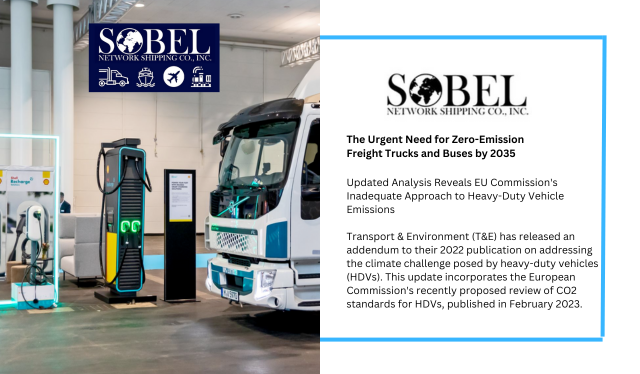Updated Analysis Reveals EU Commission’s Inadequate Approach to Heavy-Duty Vehicle Emissions
Transport & Environment (T&E) has released an addendum to their 2022 publication on addressing the climate challenge posed by heavy-duty vehicles (HDVs). This update incorporates the European Commission’s recently proposed review of CO2 standards for HDVs, published in February 2023. The analysis examines the impact of the Commission’s proposal on emissions trajectory, energy consumption, and the EU’s carbon budget for the years 2030, 2040, and 2050. It further compares the Commission’s proposal with current policies and the more ambitious targets put forth by T&E regarding HDV CO2 standards.
Between 1990 and 2019, emissions from trucks and buses witnessed a staggering 28% increase. Without additional measures, HDVs are projected to consume 60.9% of the EU’s remaining carbon budget for a 1.5°C world. By 2030, oil consumption from HDVs would surge by 3.8% due to the continued growth in HDV activity, assuming current policies remain in place.
While the Commission’s proposal aims to address Europe’s heavy-duty climate problem, T&E’s analysis reveals that their CO2 targets for HDVs fall significantly short of delivering on the EU’s climate objectives. Despite the EU Climate Law’s commitment to achieving a fully decarbonized economy by 2050, the proposed targets would only result in a 56% reduction in emissions from HDVs compared to 1990 levels. Moreover, even after 2050, 40% of the diesel fleet would remain on the roads, surpassing the average truck retirement age by 7 to 8 years. Additionally, the Commission’s proposal allows the continued sale of new diesel trucks beyond 2050 by neglecting to set a 100% zero-emission sales deadline. Furthermore, almost 20% of HDV sales are exempt from the reduction targets specified in the regulation.
On the other hand, T&E’s recommended targets would achieve a remarkable 94% reduction in CO2 emissions by 2050, with the remaining diesel fleet nearing retirement age.
2030 target lags behind industry commitments
Six out of seven major truck manufacturers in the EU have publicly announced the share of new sales that will be zero-emission by 2030. Combining these announcements, it is projected that 47% of new EU truck sales (equivalent to 9% of the total fleet size) will be battery electric (BEV) or hydrogen fuel cell (FCEV) vehicles by 2030. In discussions with the German government, known as the ‘Cleanroom talks,’ manufacturers have even estimated a higher uptake of 63% zero-emission sales by 2030. In light of this, T&E recommends raising the 2030 CO2 target under the HDV CO2 standards from the Commission’s proposed -45% to -65%. This aligns with the voluntary commitments and projections made by the industry itself.
Infrastructure and energy consumption considerations
Challenges related to charging and refueling infrastructure are often cited as the main obstacles to accelerating the sales of zero-emission trucks and buses. However, T&E’s analysis demonstrates that the anticipated public infrastructure outlined in the Alternative Fuels Infrastructure Regulation (AFIR) will sufficiently support a more ambitious -65% target for 2030.
Zero-emission vehicles offer the added advantage of being significantly more energy-efficient than diesel trucks. Given the projected 34% increase in HDV activity between 2019 and 2050, the sector urgently needs to break free from its reliance on oil. T&E’s recommended targets could


